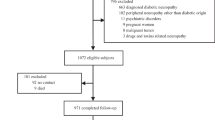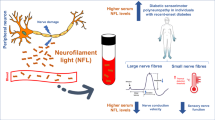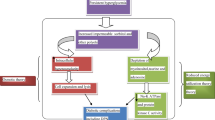Abstract
Evidence suggests that peripheral nerve injury occurs during the early stages of disease with mild glycemic dysregulation. Two proteins, neuron-specific enolase (NSE) and neurofilament light chain (NFL), have been examined previously as possible markers of neuronal damage in the pathophysiology of neuropathies. Herein, we aimed to determine the potential value of circulatory NSE and NFL mRNA levels in prediabetic patients and in those with peripheral neuropathy. This prospective clinical study included 45 prediabetic patients and 30 age- and sex-matched controls. All prediabetic patients were assessed with respect to diabetes-related microvascular complications, such as peripheral neuropathy, retinopathy and nephropathy. mRNA levels of NSE and NFL were determined in the blood by real-time polymerase chain reaction. NSE mRNA levels were similar between prediabetic and control groups (p > 0.05), whereas NFL mRNA levels were significantly higher in prediabetics than in controls (p < 0.001). NSE mRNA levels did not significantly differ between prediabetic patients with and without peripheral neuropathy (p > 0.05), while NFL mRNA levels were significantly higher in prediabetics with peripheral neuropathy than in those without (p = 0.038). According to correlation analysis, NFL mRNA levels were positively correlated with the Douleur Neuropathique 4 questionnaire score in prediabetic patients (r = 0.302, p = 0.044). This is the first study to suggest blood NFL mRNA as a surrogate marker for early prediction of prediabetic peripheral neuropathy, while NSE mRNA levels may be of no diagnostic value in prediabetic patients.
Similar content being viewed by others
References
Singleton JR, Smith AG, Russell JW, Feldman EL (2003) Microvascular complications of impaired glucose tolerance. Diabetes 52(12):2867–2873
Smith AG, Singleton JR (2008) Impaired glucose tolerance and neuropathy. The neurologist 14(1):23–29. doi:10.1097/NRL.0b013e31815a3956
Rajabally YA (2011) Neuropathy and impaired glucose tolerance: an updated review of the evidence. Acta Neurol Scand 124(1):1–8. doi:10.1111/j.1600-0404.2010.01425.x
Cappellari A, Airaghi L, Capra R, Ciammola A, Branchi A, Levi Minzi G, Bresolin N (2005) Early peripheral nerve abnormalities in impaired glucose tolerance. Electromyogr Clin Neurophysiol 45(4):241–244
Singleton JR, Smith AG, Bromberg MB (2001) Increased prevalence of impaired glucose tolerance in patients with painful sensory neuropathy. Diabetes Care 24(8):1448–1453
Novella SP, Inzucchi SE, Goldstein JM (2001) The frequency of undiagnosed diabetes and impaired glucose tolerance in patients with idiopathic sensory neuropathy. Muscle Nerve 24(9):1229–1231
Sumner CJ, Sheth S, Griffin JW, Cornblath DR, Polydefkis M (2003) The spectrum of neuropathy in diabetes and impaired glucose tolerance. Neurology 60(1):108–111
Divisova S, Vlckova E, Hnojcikova M, Skorna M, Nemec M, Dubovy P, Dusek L, Jarkovsky J, Belobradkova J, Bednarik J (2012) Prediabetes/early diabetes-associated neuropathy predominantly involves sensory small fibres. J Peripher Nerv Syst 17(3):341–350. doi:10.1111/j.1529-8027.2012.00420.x
Smith AG, Sheryl T, Singleton JR (2000) Skin biopsy findings in patients with neuropathy associated with diabetes and impaired glucose tolerance (IGT). Neurology 54(7):A368–A368
Thomsen NO, Englund E, Thrainsdottir S, Rosen I, Dahlin LB (2009) Intraepidermal nerve fibre density at wrist level in diabetic and non-diabetic patients. Diabet Med 26(11):1120–1126. doi:10.1111/j.1464-5491.2009.02823.x
Arimura A, Deguchi T, Sugimoto K, Uto T, Nakamura T, Arimura Y, Arimura K, Yagihashi S, Nishio Y, Takashima H (2013) Intraepidermal nerve fiber density and nerve conduction study parameters correlate with clinical staging of diabetic polyneuropathy. Diabetes Res Clin Pract 99(1):24–29. doi:10.1016/j.diabres.2012.09.026
Beiswenger KK, Calcutt NA, Mizisin AP (2008) Epidermal nerve fiber quantification in the assessment of diabetic neuropathy. Acta Histochem 110(5):351–362. doi:10.1016/j.acthis.2007.12.004
Butt AN, Shalchi Z, Hamaoui K, Samadhan A, Powrie J, Smith S, Janikoun S, Swaminathan R (2006) Circulating nucleic acids and diabetic complications. Ann N Y Acad Sci 1075:258–270. doi:10.1196/annals.1368.034
Chan AK, Chiu RW, Lo YM, Clinical Sciences Reviews Committee of the Association of Clinical B (2003) Cell-free nucleic acids in plasma, serum and urine: a new tool in molecular diagnosis. Ann Clin Biochem 40(Pt 2):122–130. doi:10.1258/000456303763046030
Hamaoui K, Butt A, Powrie J, Swaminathan R (2004) Concentration of circulating rhodopsin mRNA in diabetic retinopathy. Clin Chem 50(11):2152–2155. doi:10.1373/clinchem.2004.037168
Sandhu HS, Butt AN, Powrie J, Swaminathan R (2008) Measurement of circulating neuron-specific enolase mRNA in diabetes mellitus. Ann N Y Acad Sci 1137:258–263. doi:10.1196/annals.1448.044
Kaiser E, Kuzmits R, Pregant P, Burghuber O, Worofka W (1989) Clinical biochemistry of neuron specific enolase. Clin Chim Acta 183(1):13–31
Jordanova A, De Jonghe P, Boerkoel CF, Takashima H, De Vriendt E, Ceuterick C, Martin JJ, Butler IJ, Mancias P, Papasozomenos S, Terespolsky D, Potocki L, Brown CW, Shy M, Rita DA, Tournev I, Kremensky I, Lupski JR, Timmerman V (2003) Mutations in the neurofilament light chain gene (NEFL) cause early onset severe Charcot-Marie-Tooth disease. Brain 126(Pt 3):590–597
Kuchel GA, Poon T, Irshad K, Richard C, Julien JP, Cowen T (1997) Decreased neurofilament gene expression is an index of selective axonal hypotrophy in ageing. NeuroReport 8(3):799–805. doi:10.1097/00001756-199702100-00044
Hoffman PN, Cleveland DW, Griffin JW, Landes PW, Cowan NJ, Price DL (1987) Neurofilament gene-expression—a major determinant of axonal caliber. Proc Natl Acad Sci USA 84(10):3472–3476. doi:10.1073/pnas.84.10.3472
Bhagavati S, Maccabee PJ, Xu W (2009) The neurofilament light chain gene (NEFL) mutation Pro22Ser can be associated with mixed axonal and demyelinating neuropathy. J Clin Neurosci 16(6):830–831. doi:10.1016/j.jocn.2008.08.030
American Diabetes A (2009) Diagnosis and classification of diabetes mellitus. Diabetes Care 32(Suppl 1):S62–67. doi:10.2337/dc09-S062
Bouhassira D, Attal N, Alchaar H, Boureau F, Brochet B, Bruxelle J, Cunin G, Fermanian J, Ginies P, Grun-Overdyking A, Jafari-Schluep H, Lanteri-Minet M, Laurent B, Mick G, Serrie A, Valade D, Vicaut E (2005) Comparison of pain syndromes associated with nervous or somatic lesions and development of a new neuropathic pain diagnostic questionnaire (DN4). Pain 114(1–2):29–36. doi:10.1016/j.pain.2004.12.010
Chandy A, Pawar B, John M, Isaac R (2008) Association between diabetic nephropathy and other diabetic microvascular and macrovascular complications. Saudi J Kidney Dis Transplant 19(6):924–928
Lupachyk S, Watcho P, Hasanova N, Julius U, Obrosova IG (2012) Triglyceride, nonesterified fatty acids, and prediabetic neuropathy: role for oxidative-nitrosative stress. Free Radical Biol Med 52(8):1255–1263. doi:10.1016/j.freeradbiomed.2012.01.029
Marangos PJ, Schmechel DE (1987) Neuron specific enolase, a clinically useful marker for neurons and neuroendocrine cells. Annu Rev Neurosci 10:269–295. doi:10.1146/annurev.ne.10.030187.001413
Ramont L, Thoannes H, Volondat A, Chastang F, Millet MC, Maquart FX (2005) Effects of hemolysis and storage condition on neuron-specific enolase (NSE) in cerebrospinal fluid and serum: implications in clinical practice. Clin Chem Lab Med 43(11):1215–1217. doi:10.1515/Cclm.2005.210
Massabki PS, Silva NP, Lourenco DM, Andrade LEC (2003) Neuron specific enolase concentration is increased in serum and decreased in platelets of patients with active systemic sclerosis. J Rheumatol 30(12):2606–2612
Singh HV, Pandey A, Shrivastava AK, Raizada A, Singh SK, Singh N (2013) Prognostic value of neuron specific enolase and IL-10 in ischemic stroke and its correlation with degree of neurological deficit. Clin Chim Acta 419:136–138. doi:10.1016/j.cca.2013.02.014
Chabok SY, Moghadam AD, Saneei Z, Amlashi FG, Leili EK, Amiri ZM (2012) Neuron-specific enolase and S100BB as outcome predictors in severe diffuse axonal injury. J Trauma Acute Care 72(6):1654–1657. doi:10.1097/Ta.0b013e318246887e
Selakovic V, Raicevic R, Radenovic L (2005) The increase of neuron-specific enolase in cerebrospinal fluid and plasma as a marker of neuronal damage in patients with acute brain infarction. J Clin Neurosci 12(5):542–547. doi:10.1016/j.jocn.2004.07.019
Gaiottino J, Norgren N, Dobson R, Topping J, Nissim A, Malaspina A, Bestwick JP, Monsch AU, Regeniter A, Lindberg RL, Kappos L, Leppert D, Petzold A, Giovannoni G, Kuhle J (2013) Increased neurofilament light chain blood levels in neurodegenerative neurological diseases. PLoS ONE 8(9):e75091. doi:10.1371/journal.pone.0075091
Fialova L, Bartos A, Svarcova J, Zimova D, Kotoucova J, Malbohan I (2013) Serum and cerebrospinal fluid light neurofilaments and antibodies against them in clinically isolated syndrome and multiple sclerosis. J Neuroimmunol 262(1–2):113–120. doi:10.1016/j.jneuroim.2013.06.010
Scherling CS, Hall T, Berisha F, Klepac K, Karydas A, Coppola G, Kramer JH, Rabinovici G, Ahlijanian M, Miller BL, Seeley W, Grinberg LT, Rosen H, Meredith J Jr, Boxer AL (2013) Cerebrospinal fluid neurofilament concentration reflects disease severity in frontotemporal degeneration. Ann Neurol. doi:10.1002/ana.24052
Acknowledgments
This study was funded by the Bozok University Scientific Research Project Unit (2013 TF/A36) and was conducted at Bozok University Hospital.
Author information
Authors and Affiliations
Corresponding author
Rights and permissions
About this article
Cite this article
Celikbilek, A., Tanik, N., Sabah, S. et al. Elevated neurofilament light chain (NFL) mRNA levels in prediabetic peripheral neuropathy. Mol Biol Rep 41, 4017–4022 (2014). https://doi.org/10.1007/s11033-014-3270-y
Received:
Accepted:
Published:
Issue Date:
DOI: https://doi.org/10.1007/s11033-014-3270-y




